Camping is about connecting—to nature, to wildlife, to the earth and to each other. As I was thinking about great camping recipes to share, I had to really ponder what kinds of meals feel good to make and eat while in the outdoors. The answer was simple: meals that make us feel connected to our families and connected to nature. The following camping recipes are healthy, using fresh foods found in nature, and they’re all fun, active meals that families can enjoy cooking together.
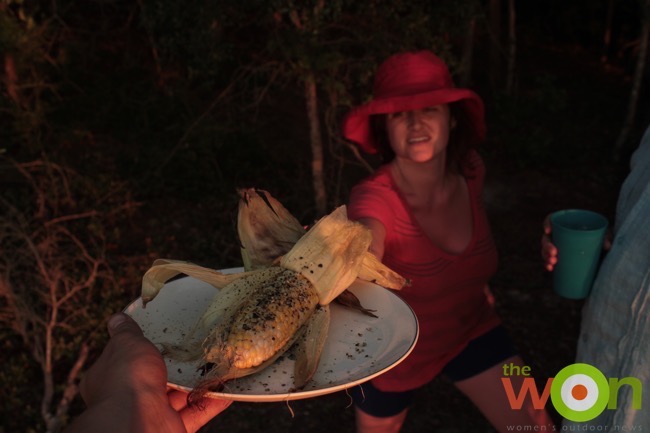
Camping connects us to nature, and food connects us to each other. In this photo, Denise Pasquinelli is about to enjoy a piece of barbequed nori shake corn on the cob (recipe below)
As I started compiling healthy and all-natural recipes, I knew that I had to reach out to my lovely friend from college, Denise Pasquinelli. Whenever I find myself scrolling through photos on social media, I always stop and drool over Denise’s photos of natural and healthy meals. Denise has a gorgeous garden that she clearly pours her heart and soul into, and she is an expert on connection to the earth and to the fresh, organic recipes she prepares and shares.
It’s no wonder that she has such amazing recipes and advice regarding food, wellness and connection to nature: Denise is a holistic health coach and creator of SEED Holistic Health and Wellness.
SEED stands for: Simplify, Eat authentically, Elevate consciousness and Delight in what could be. These concepts are at the foundation of her programs centered on food, health and spirituality.
As you prepare for your next camping trip, be sure to pick a few of the recipes below and give them a try. I’d love your feedback and comments, too. What are some of your favorite camping recipes?
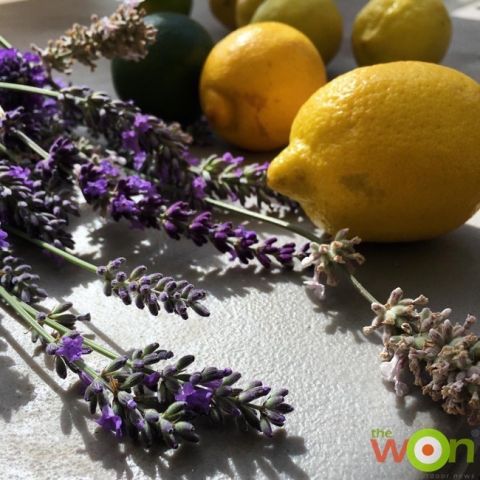
Growing up camping, I remember my parents always having some type of sun-tea brewing. This recipe offers a fresh and delightful alternative to typical sun teas. (Denise Pasquinelli photo)
This is a refreshing drink to make as a fun activity while enjoying nature.
Beautiful and delicious!
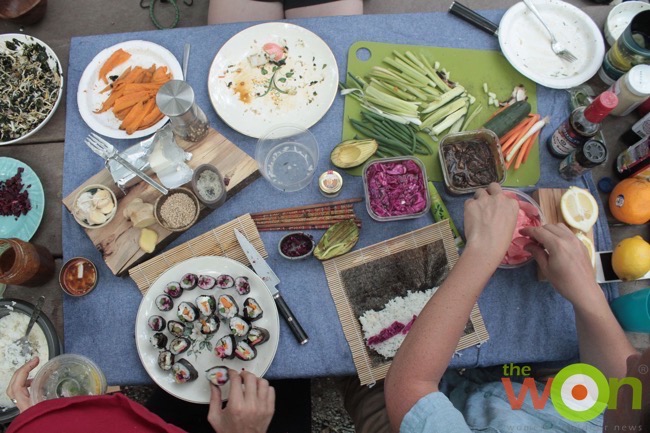
Sushi is a fun, healthy, and beautiful family activity. What could be a better thing to do while spending time in the great outdoors together? (Denise Pasquinelli photo)
I’ll be honest: I’ve never associated camping with sushi. But when Denise shared her sushi-making camping adventure with me, I couldn’t wait to get out and try it for myself. Not only is this a fresh and healthy meal, but it’s also an activity the whole family can take part in. It’s especially great for kids who like to have some authority over their food; it lets them be the chef, but ensures a healthy meal.
Place a piece of nori on a sushi mat, add a scoop of sushi rice, and spread the rice out so that a thin layer covers the seaweed. Add your fillings to the middle of the open roll (be careful not to make it too bulky). Carefully roll one side of your sushi up by picking up an edge of the sushi mat so that your square, open-faced sushi turns into an actual roll. Continue rolling the sushi up inside your sushi mat until you’re left with one long, tubular roll. Slice the roll into several small pieces (the nori can be tough to cut through; this should be a grown-up’s job). Garnish as desired, and dig in.
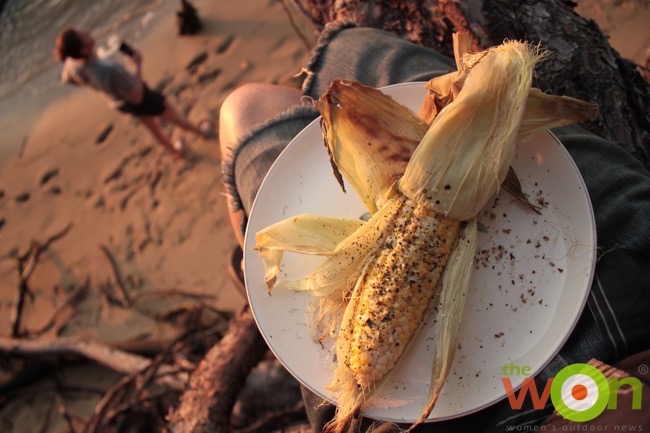
Nothing is better than a simple and all natural meal to help you to feel connected to the outdoors. (Denise Pasquinelli photo)
This recipe is so simple yet delicious; it’s just silly not to try it.
For the corn: you can either boil corn in a pot over the campfire or grill ears of corn over the open flame. Once your corn is cooked, add butter, a sprinkle of parmesan cheese (optional) and a liberal dousing of the nori shake. As an added bonus, this nori shake is amazing on everything: plain rice, salads, steamed veggies, you name it.
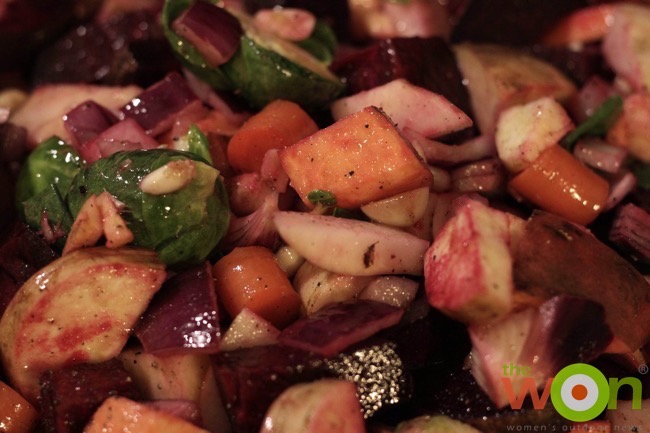
Food that comes directly from nature is best eaten while in nature. These roots are beautiful, colorful, and amazingly tasty. (Denise Pasquinelli photo)
As a child, we always had hash for at least one of our meals during any camping trip. My dad would always bake a few potatoes before leaving for our trip. Then he would fry up the pre-cooked potatoes with some meat, onions, peas, salt and pepper. To this day, I’ll make this for dinner every now and then; the flavor always brings back memories of camping as a child.
This recipe is a modern and healthy twist on standard hash.
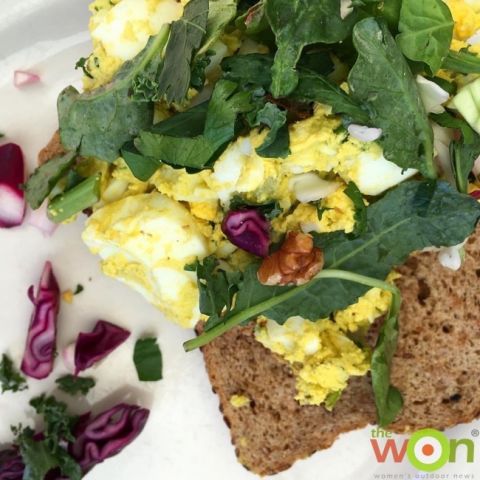
For this batch of egg salad, Denise added celery, fresh parsley, fresh cilantro, scallions, mustard, lemon juice, and avocado. She topped the salad with fresh greens and some whole grain seedy bread. (Denise Pasquinelli photo)
This is another recipe I would not have associated with camping, but eggs are healthy and delicious, and egg salad offers wonderful opportunities for kids to help choose ingredients, peel and mash the eggs, and mix everything together.
For this recipe, get creative. Try different ingredients, or eating it with wheat crackers, toast, or grainy or seedy bread. Have fun with it. I usually use 3 eggs per adult and 2 per child, and end up with leftovers. This recipe is for four adults, but you can size up or down accordingly.
OK, now it’s your turn—share your own favorite recipes and photos of campfire cooking below. I’m excited to learn new recipes from you to try on my next camping trip.
Denise Pasquinelli received her certificate in Holistic Health Coaching from the Institute of Integrative Nutrition in New York City. She also has a Masters in Library and Information Science from the Pratt Institute.
Denise’s goal with SEED is to bring together the magic of earth-based spirituality, plant-based medicine, positive psychology and current trends in holistic health and dietary theory to serve your health and wellness in a pragmatic and actionable way. The program also heavily focuses on preserving the health of our one precious planet. SEED offers personalized coaching to help you achieve your health goals, 10-day Ayurvedic-based cleanses, plant-based cooking classes, secret suppers and edible inspiration.
This Retro WON first appeared October 4, 2016.
Casey Monteleone is excited to be a guest outdoor columnist at The WON. She is proud to work at Columbia Sportswear Company, where their motto is “We Connect Active People With Their Passions.” Seeking to live out this motto, she hopes to inspire others through her writing to get outdoors, get active and live life to the fullest. Born and raised in Oregon, Casey spent the summers hiking, camping and fishing in the majestic mountains of rural Eastern Oregon. Her parents taught her from a young age how to survive in the wilderness with bare essentials, and how to truly appreciate the beauty and tranquility of the great outdoors. As she grew up, Casey continued to pursue various outdoor activities … From exciting adventures like kayaking, canoeing, hunting, and skiing ... to relaxing outings where she plays on the beach with her family ... to taking her yellow lab to the Columbia River Gorge for a swim. Casey went on to earn her degree in Mass Communications with an emphasis on Environmental Studies from Linfield College, and happily resides near Portland with her 2 amazing girls, loving fiancé, and sweet dog. Casey is passionate about sharing her love of the great outdoors, and is so happy to have the opportunity to contribute to The WON, and work with such an amazing team of inspirational women. View all posts by Casey Monteleone